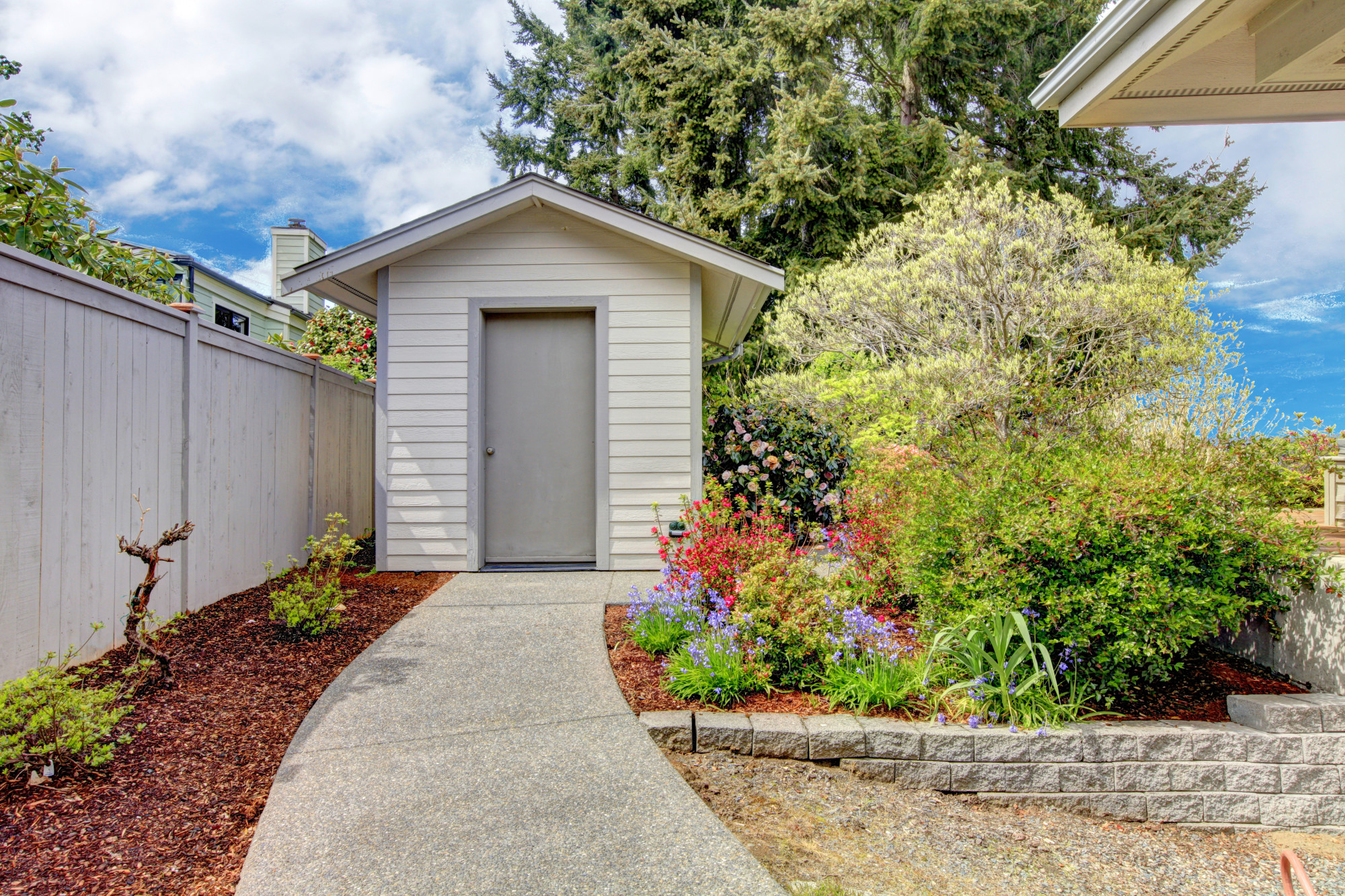The more you invest in your home and landscaping, the more you’ll acquire tools and outdoor equipment that need a place to land. An outdoor shed is an ideal solution because of its proximity to your yard and the substantial space it offers.
To save money, you may consider building your own shed. While it’s a large project, with a few instructions and a lot of time, you can make it happen.
Here are the basic instructions for how to build a shed, from foundation to finishing touches.
Table of Contents
Making Plans for How to Build a Shed
You can hire someone to help you draw up plans, but if you can’t read building blueprints, this won’t help you. It may be best to create your own plans. Read through all the directions in this post and do your own research to get the full scope of the project.
It’s helpful to make drawings of how you understand the pieces fitting together. Even if you’re not an artist, at least this helps you know what you’re aiming for.
Then make several lists, including a list of materials you’ll need. Make a list of cuts you need if you plan to have the store do them for you. Finally, a budget sheet with estimated costs helps you keep track of prices as you compare them at different suppliers.
Depending on what is helpful to you, making a to-do list with step-by-step tasks can help you understand the project better and keep yourself on track. If you have help with the building project, then a task list will keep others informed, too.
Foundation
You can build a foundation for your shed with wood by putting in deck piers (or 6×6 posts) after you’ve leveled the ground. Align the piers in rows, so that you can add a support beam on top of every three piers. Then use a hurricane clip to attach each beam to the piers, with at least four screws in each.
Keep in mind that standard plywood sheets are 12’x8′, so you should place your piers distances apart that are divisible by 4 or 6.
Add rim joints on the outside, then install floor joists all across the floor. Add the plywood decking on top of the joists. If needed, get the plywood sheets cut at the home improvement store for a small fee so they’re snug.
Alternate Foundation: Concrete Slab
If you’d rather have a concrete floor, you can pour your own for about the same cost as the wood foundation. You’ll need to build a strong form for the concrete first. This is a project best supervised by a more experienced builder, someone who’s worked with concrete before.
Check to make sure you don’t need a building permit, and then prepare the site by leveling the ground (call 811 before digging). Sand is best for the pour site, but clay is okay if you remove some of the topsoil and add gravel.
Set stakes around the outside of where the concrete will go. Then use 2×12 boards for the outside of the form, checking before you buy them that they are straight and not bowed. Attach them to the stakes, and then build braces all along the outside with 2x4s so the concrete doesn’t push the form out while it dries.
Then you’re ready to hire a ready-mix company to pour the concrete. They can help you calculate how much you’ll need, and all that’s left is to prepare the lawn for the truck to back up to the spot.
Level the slab with a screed board and then a trowel as soon as it’s poured, to prevent quick drying before the concrete is smooth. Use an edger to round off slab edges. Spray with curing compound and let it harden overnight before removing the form.
Framing
If your foundation is built, you’re ready to frame the walls. Pay attention to making square corners. Even one that’s off will throw off the whole project.
Measure several times and only cut once, if you’re sure your measurements are accurate. Use 2×4 wall studs for the ends, and double 2x4s for the top plate. Space studs no more than 16″ apart. Closer spacing like 12″ makes it easier to hang tools securely inside the shed after it’s built.
Use anchor plates and bolts to secure the walls. After you have them up and the screws part way in, check that they’re aligned before you fasten the bolts down too securely.
Use your level and your square to double check. Then use a tape measure diagonally across the whole wall frame and the Pythagorean theorem to calculate the accuracy of placement. Make any necessary adjustments before you fix the anchors in place.
Door and Windows
For walls in which you want to add a window or door, the framing is a little different. Measure and leave a big enough gap between studs so you can install a door or window in the space.
Add a brace above the door frame, or for a window, above and below the placement. You’ll also need to install two supports above the window in place of studs and two below it.
To install a window, place it in the measured out hole you’ve left. Add shims if necessary to make the window level. Use a level and a tape measure to make sure it’s square and adjust as needed.
Nail through the nailing fin into the framing to secure the window in place. Drive them into the wood, and set them below the wood surface. Add caulk to seal the edges, and you’re finished.
Put in the door the same way, using a prehung door with hardware already installed. Place the door, frame and all, into the space you left for it in the wall, secure it with nails, and add caulk to seal the edges.
Installing the Roof
Get help from your home improvement store to order the right size trusses for your shed. Once they come in, use hurricane plates or slotted anchors to secure them in place. Make sure you install trusses so they’re aligned, and pay attention to any special instructions from the manufacturer.
To build the rest of the roof, you need plywood decking. Again, the store can cut the sheets down if you pre-measure. Be safe on the roof — a sheet of decking can act like a sail when there is a strong wind. Nail the sheets of decking to the trusses.
Next install the ice and water shield, better than basic tar paper for keeping your building dry. Try a hammer tacker tool (a slap hammer), instead of a regular staple gun. Next, install the drip edge along the edges of the roof.
Then use a nail gun to attach the shingles, starting from the bottom edge and working toward the ridge. The last step is installing the ridge cap; because cap shingles are bent, they wear out faster. Use special ridge cap shingles to make sure they last the lifespan of the roof (about 20 years).
Roofing alone is a big project, let alone building the rest of the shed from the ground up. If you aren’t looking to put in this much work on your outbuildings, consider options like outdoor shed kits or vinyl sheds that come already built. It’s worth the investment if your construction confidence isn’t quite up to snuff for a big project like this.
A Peaceful Garden Shed
Building your own place to store tools and equipment means you can save money. These steps for how to build a shed will help you understand the project and get you started planning the details. Make sure you do additional research if there are any points you’re not confident about, before attempting to jump right in.
Part of keeping your landscaping in top condition is caring for your tools, and your new shed will help you do that. For more help curating your living space, read more today.


















